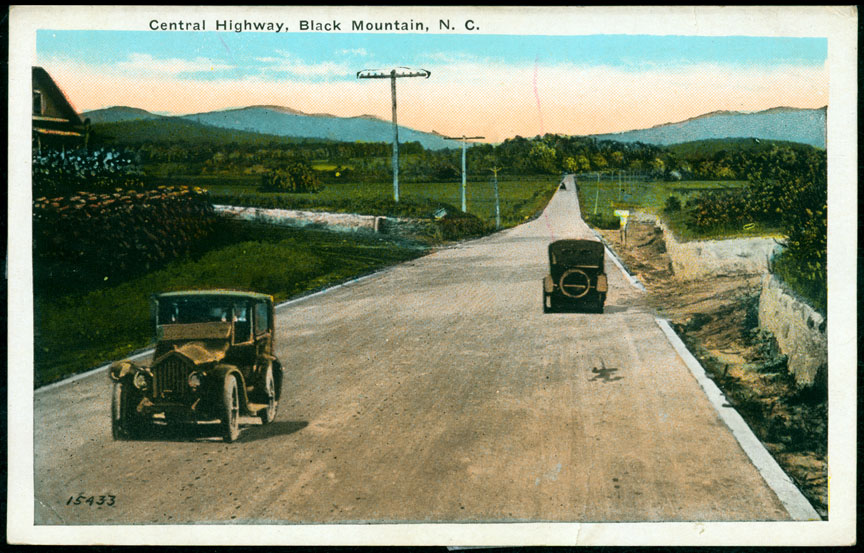In 1919, a movement was afoot for better roads throughout North Carolina. In the western part of the state, residents were particularly vocal about improving travel between Asheville and Black Mountain.
On March 30, The Asheville Citizen published a letter by local resident W.L. Wolslagel, who described the current roadway as “an abomination, as well as a disgrace.” He implored commissioners to “[l]et us have a good road and have it at once.” The results, he maintained, would benefit all:
“That the farmer may market his crops without delay, that travelers may ride with some degree of comfort and not such a strain upon their vehicles, and that all of Western North Carolina may be benefitted I say again, let us have this road by all means.”
Momentum for the movement continued to grow. The following day, The Asheville Citizen reported on a mass meeting organized by Black Mountain residents interested in upgrading the thoroughfare. “This road has always been one of importance,” the paper noted, “especially since the establishment of the large religious institutions at Montreat and Blue Ridge, and road enthusiasts are highly in favor of improving it.”
In April, Buncombe County commissioners met with advocates to discuss the road project. During the gathering, one resident, Alexander Porter, implored the county officials “to lead the way into a new era of … development.”
The paper applauded Porter’s ask, writing:
“Good roads and publicity, Mr. Porter. That is to be the slogan in the new period of Buncombe’s and Western Carolina’s history. Either that or ‘let well enough alone,’ which means stagnation and an era of cheap scratching the surface of our resources while other communities dig into rich subsoil and produce an abundant harvest.”
Commissioners paid heed. In June, funding for the project was approved by the state highway commission. Work on the new road was scheduled to begin within the next 60 days; early reports projected its completion that fall.
On July 15, 1919, The Asheville Citizen announced that the commissioners were seeking bids “for the construction of a macadam road, fourteen feet wide and rolled to a depth of seven inches.” But by August, the Highway Division of the Board of Trade adopted a resolution requesting Buncombe County commissioners find alternative options.
According to The Asheville Citizen, an investigation by the board determined macadam was “the most expensive road that can be built and entirely inefficient as a road surface.” Along with being a financial drain to the county, the investigation also determined that macadam wore down “tires and machines of automobile users” more quickly than concrete-based asphalt. The county ultimately decided to go with the latter.
After much delay, work finally began in October, with a new completion date projected for the summer. But by February 1920, the latest prediction appeared to go up in flames when a fire destroyed one of the construction site’s largest sleeping quarters. Despite the initial setback and shock, work soon continued.
That spring, however, more bad news arrived. On May 18, 1920, The Asheville Citizen reported that road construction was at a standstill due to a labor shortage. Local residents, the article stated, “[were] too busy farming to stop and work on the road.”
Misfortune continued into the summer. By then, the labor issue had been resolved, but a new shortage of available railcars limited the delivery of required materials. On July 18, 1920, The Sunday Citizen informed readers that the project would close indefinitely. “[T]his announcement will be received with genuine regret by thousands of autoists and tourists who have been anxiously awaiting the time when this highway would be opened,” the paper wrote.
The shutdown proved short-lived. Construction resumed that fall. On Nov. 28, 1920, The Sunday Citizen proclaimed that, barring inclement weather, the road would be finished by Christmas. Once complete, the article continued, motorists driving between Asheville and Black Mountain would be able to “travel every foot of the distance without touching a dirt highway.”
As with earlier predictions, Christmas came and went without seeing the project through. Spring 1921 unfolded in similar fashion.
But on June 21, 1921, motorists finally got their chance to traverse the region’s newest section of paved highway. The 20-month project, which stretched 7.79 miles, had cost the county and state $350,000. In that moment of celebration, though, neither cost nor delay mattered.
On the day of its opening, The Asheville Citizen declared:
“With the tearing down of the barriers … the way is opened for closer co-operation between the cities of Western North Carolina; the tourist is given added encouragement to pass through this section; the death toll of accidents on dangerous curves and crossings is practically eliminated … and another great step forward is made in the progress of this section of the state.”
Editor’s note: Peculiarities of spelling and punctuation are preserved from the original documents.



You sure that’s a photo? It looks like an artist’s rendition to me. I used to ride that curvy road many a time during the 40’s, 50’s, and 60’s when we lived in Asheville and our paternal grandmother lived in Marion. I don’t believe there was any part of Highway 70 that straight except one section near Ridgecrest and another in the Oteen-Swannanoa area. Once you passed Ridgecrest it was an endless series of twists and turns.
The boys got to ride in the back seat and the girl up front because she always got car-sick in the curves unless she was in the front seat between mommy and daddy. She learned very quickly how to simulate nausea and got out of the car on a curvy mountain road between Black Mountain and Marion and pretended to regurgitate.
We used to sing songs like “The Bear Went Over the Mountain” to break the monotony of the long trip to Marion, usually in an underpowered 1952 Chevrolet Powerglide, six banger. Yes, and the sister’s high caste always put her in the front seat, and the boys, a lesser caste, in the back.